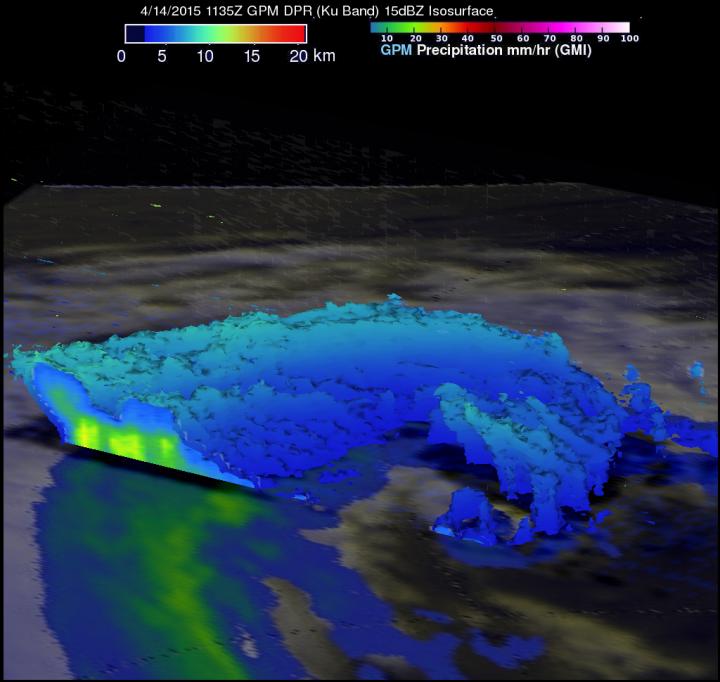GPM sees wind shear affecting remnants of Extra-tropical Cyclone Joalane

GPM data from April 14 showed that Joalane's highest storm tops were as high as 9.37 km (5.8 miles) in rain bands south of Joalane's center of circulation. Image Credit: SSAI/NASA, Hal Pierce
The Global Precipitation Measurement (GPM) core observatory satellite had a last look at the remnants of Tropical Cyclone Joalane on April 14, 2015 at 1135 UTC (4:35 p.m. local time/7:35 a.m. EDT/U.S.).
GPM's Microwave Imager (GMI) instrument found very little rainfall around Joalane's center and light to moderate rainfall in bands on the outer edges of the rapidly weakening tropical cyclone.
At NASA's Goddard Space Flight Center in Greenbelt, Maryland, reflectivity data derived from the Ku band on GPM's dual frequency radar was used to create a three-dimensional image of the extra-tropical cyclone.
The 3-D image showed cloud tops were tilted toward the south, clearly indicating how strongly vertical shear was affecting the rapidly weakening tropical cyclone. GPM data showed that Joalane's highest storm tops were as high as 9.37 km (5.8 miles) in rain bands south of Joalane's center of circulation.
Joalane continued to weaken and is expected to dissipate in a day or two.
Media Contact
All latest news from the category: Earth Sciences
Earth Sciences (also referred to as Geosciences), which deals with basic issues surrounding our planet, plays a vital role in the area of energy and raw materials supply.
Earth Sciences comprises subjects such as geology, geography, geological informatics, paleontology, mineralogy, petrography, crystallography, geophysics, geodesy, glaciology, cartography, photogrammetry, meteorology and seismology, early-warning systems, earthquake research and polar research.
Newest articles

Properties of new materials for microchips
… can now be measured well. Reseachers of Delft University of Technology demonstrated measuring performance properties of ultrathin silicon membranes. Making ever smaller and more powerful chips requires new ultrathin…

Floating solar’s potential
… to support sustainable development by addressing climate, water, and energy goals holistically. A new study published this week in Nature Energy raises the potential for floating solar photovoltaics (FPV)…

Skyrmions move at record speeds
… a step towards the computing of the future. An international research team led by scientists from the CNRS1 has discovered that the magnetic nanobubbles2 known as skyrmions can be…




















